"Some
of the time, there is no explanation for
high blood pressure
Many people are unaware that they have the condition.
That is why hypertension is referred to as a "silent
killer."
Be
aware of
high blood pressure before it causes serious
health problems.
More than 65 million Americans are estimated to have high
blood pressure. High blood pressure occurs more often in
darker people—in 32% of black adults compared with
23% of whites and 23% of Mexican Americans. It also occurs
with high frequency in people whose ancestors are from China
or Japan. The consequences of high blood pressure are worse
for darker people. High blood pressure occurs more often
in older people—in about three fourths of women and
almost two thirds of men aged 75 or older, compared with
only about one fourth of people aged 20 to 74. People who
have normal blood pressure at age 55 have a 90% risk of developing
high blood pressure. High blood pressure is twice as common
among people who are obese as among those who are not.

Blood pressure is a measurement of the force applied to
the walls of the arteries as the heart pumps blood through
the body. The pressure is determined by the force and amount
of blood pumped, and the size and flexibility of the arteries.

The normal blood pressure range of persons aged 20 – 40
years is 120mm Hg systolic pressure and 80mm Hg diastolic
pressure.=120/80mmHg. Anyone registering above this range
is classed as having high blood pressure.
The Systolic pressure is when the heart`s ventricles contract
and push the blood through the veins. It is called the systole,
the pressure during heartbeat action. The Diastolic pressure
is the lower pressure that results when air is released out
of the cuff and no more sound is heard. This is called the
diastole; the artery resting pressure.
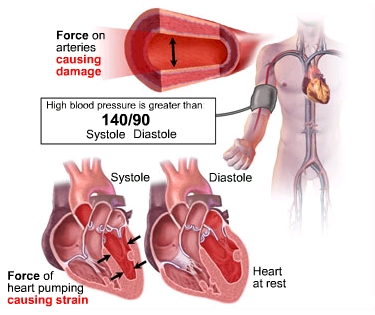
The normal blood pressure range can vary depending on what
age you are.
It increases with age when the elasticity of arteries is
reduced.Evolution and modulation of age-related medial elastocalcinosis:
impact on large artery stiffness and isolated systolic hypertension.
Dao HH, Essalihi R, Bouvet C, Moreau P.
Blood pressure is continually changing depending on activity,
temperature, diet, emotional state, posture, physical state,
and medication use.
Laser Blood Cleansing >>>> More
Here
Fats Accumulate in Your
Arteries >>>> More
Here
Dangers of High Blood Pressure
High blood pressure is also called Hypertension, it is what
happens when someone experiences a chronic raise in their
blood pressure. The normal blood pressure reading should
be 115 over 75 or 115/75. There are typically 4 stages of
blood pressure, these stages determine how high of a risk
you are of developing some sort of blood pressure related
disease. Here are the different categories of blood pressure.

The normal range like was said before is actually between
90-119 over 60- 79. This is the normal range for someone.
The next stage is called Pre-hypertension
the numbers range between 120 - 139 over 80 - 89. This stage
is still considered OK, but you have to start watching what
you are eating, and making sure you get enough exercise.
The third stage is considered mildly high blood pressure,
it is 140 - 159 over 90 - 99. At this stage you should see
a doctor and get checked out and make sure it's not something
serious.
The last stage is high blood pressure,
and this stage is the one where you need to serious consider
going to the doctor and getting a check up. Depending how
long you have been at this stage will tell you how serious
the stage is. The numbers for this stage are anything over
160 over anything over 100. At this stage you should go to
doctor immediately.
Some of the symptoms of high blood pressure might be headaches
that are around the occipital area of the head, which is
the top of your skull. They generally occur in the mornings
and go away after a short time. Other symptoms may be dizziness,
palpitations, fatigue, and impotence. Since these symptoms
could mean a lot of different things it is recommended that
you get medical attention and find out what is causing these
things.
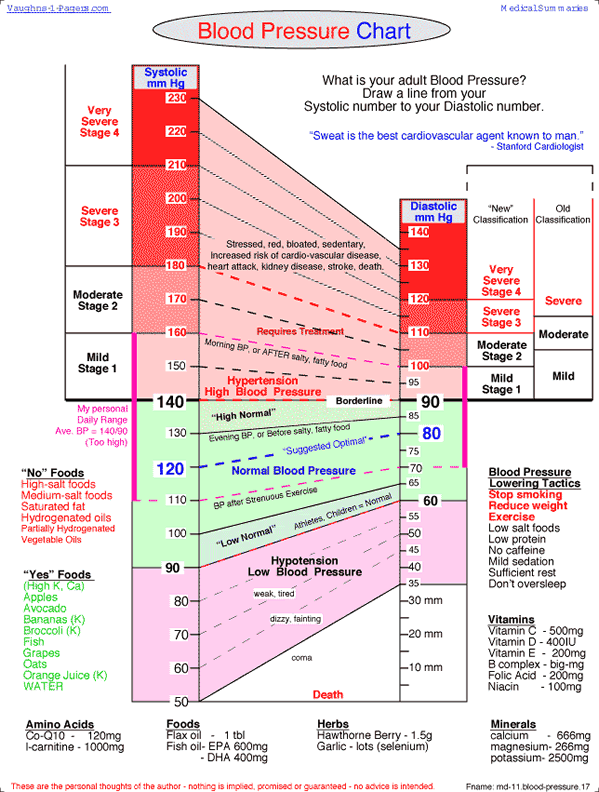
Symptoms
Most people are not aware that they have hypertension because
of a general lack of symptoms until major complications arise.
In rare cases, some people with hypertension may have headaches
or nosebleeds...Despite a general lack of symptoms, uncontrolled
hypertension damages the kidney and heart and large and small
blood vessels throughout the body. This due to the excessive
and ongoing pressure that the blood is putting on the walls
of the arteries as it is pumped from the heart throughout
the body.
Because of this "lack
of symptoms", regular medical care is
vital to monitoring blood pressure and promptly
treating
high blood pressure....Now
you can easily monitor your own blood pressure,,see
below
A few Causes of High Blood
Preasure
Smoking and Alcohol are two of the more
well known culprits behind raised blood pressure levels.
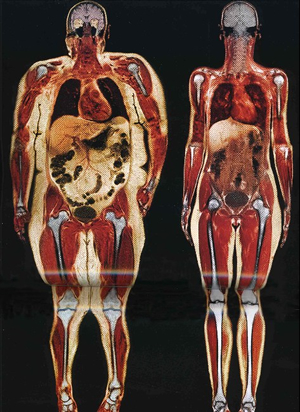
Obesity is certainly considered one of
the main causes of high diastolic blood pressure and in fact,
as high as two thirds of all people with high diastolic blood
pressure are obese and the problem is particularly relevant
to people living in the more developed nations of the world.

Conversely, high blood pressure that has one or more definite
causes is known as secondary hypertension. Secondary causes
of hypertension include pregnancy, aortic narrowing,
specific drugs, increased blood thickness and various kidney
and glandular diseases.
Reducing your weight by just 10 pounds may be enough
to lower your blood pressure. Losing weight can help
to enhance the effects of high blood pressure medication
and may also reduce other risk factors, such as diabetes
and high bad cholesterol.
|
A few Causes
of Low Blood Preasure
Many things can make your blood pressure too
low. These range in severity from normal changes caused by
pregnancy to dangerous underlying conditions, like heart
problems or hormone disturbances. Some low blood pressure
causes are simple cases of dehydration brought on by vomiting,
intense exercise, or the overuse of diuretics. Some studies
have shown that a dehydration-induced weight loss of 1 percent
is enough to trigger dizziness, confusion, or other symptoms
of low blood pressure
 |
No matter what, blood pressure shouldn’t
be too high or too low. There are four acupressure
points for treating low blood pressure: Zhong Zhu and
Yang Chi on the back of the hand, Shen Men and Tai
Ling on the palm side.
Acupuncture
Tools |
One especially important cause of low blood
pressure is orthostatic hypotension, which is sometimes referred
to as postural hypotension. This happens when blood pressure
drops rapidly during changes to body position--usually when
changing from sitting to standing--inducing classic signs
that the blood pressure is too low, like dizziness, blurry
vision, and fainting.
• Normal changes associated with the first and second
trimesters of pregnancy
• Hormone problems such as adrenal insufficiency or
thyroid disease (overactive or underactive thyroid)
• Deficiencies of essential nutrients, such as folic
acid, can cause the number of red blood cells to decrease
(anemia)
• Alterations in blood sugar, like those caused by
diabetes
• Age: Some older patients, especially those with existing
high blood pressure, can experience postprandial hypotension,
where the blood pressure drops suddenly after eating a large
meal
Stress, Blood Pressure
and Stroke Risk
Here's what you need to know about stress,
your blood pressure, and your risk for having a stroke.
The everyday stress of modern life and work can definitely
increase your blood pressure levels by accelerating your
heart rate. But this is a temporary, non permanent raising
of blood pressure levels used quite normally by the human
body to prepare you to respond to 'threats'. This is often
called the fight-or-flight response. However, it’s
not necessarily correct to say that everyday stress causes
permanently high blood pressure (hypertension).
BUT Regular stress suffered for extended periods of
time can cause hypertension through the repeated raising
of blood pressure levels as well as by stimulation of the
nervous system to produce large amounts of vasoconstricting
(artery tightening) hormones that increase blood pressure.
Factors affecting blood pressure through long term stress
include job strain, race, social environment, and emotional
distress.
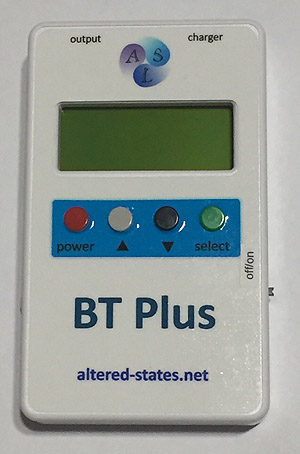 |
Stress is
most nation’s #1 health problem.
It is the source of the anxiety, depression,
and insomnia plaguing millions of people world wide.
Stress accounts for more than two-thirds
of family doctor visits and is an important risk
factor in all major illnesses. Left unchecked, it
is a killer Fix your stress lower your blood pressure click
here |
When one or more risk factors for high blood
pressure are coupled together with other stress producing
factors, the effect on blood pressure is multiplied. Also,
some of the side effects of stress, like overeating and lack
of exercise can contribute to a person developing hypertension.
Which ever way you look at it, long term stress is not good
for the human body and should be avoided and controlled wherever
possible.click
here
Know your blood pressure check it regularly; detect high
blood pressure before it causes serious health problems.
Hypertension is
also called "high blood pressure". Hypertension
is a silent killer because it is deadly and has no early
significant symptoms. The danger from hypertension is the
extra load on the heart, leading to complications such as
hypertensive heart disease. Hypertension can also seriously
damage the kidneys. And it does all this silently, without
any major symptoms, except when the high blood pressure gets
extreme.

Stress can cause hypertension through
repeated blood pressure elevations as
well as by stimulation of the nervous
system to produce large amounts of vasoconstricting
hormones that increase blood pressure.
Factors affecting blood pressure through
stress include white coat hypertension,
job strain, race, social environment,
and emotional distress. Furthermore,
when one risk factor is coupled with
other stress producing factors,
In 2014, scientists from Massachusetts
General Hospital and Harvard Medical
School investigating the link between
stress and heart attacks reported that
stress causes our bodies to make a
surplus of disease-fighting white blood
cells. That in turn can increase inflammation
in the arteries of people with a condition
called atherosclerosis, where the artery
walls are thickened by a build-up
of plaque.
What
are the warning signs of stress?
When you are exposed to long periods
of stress, your body gives warning
signs that something is wrong. These
physical, mental, emotional and behavioural
signs of stress should not be ignored.
They tell you that you need to slow
down. If you continue to be stressed
and you don’t give your body
a break, you are likely to develop
health problems. You could also aggravate
an existing illness.
Below
are some common warning signs of
stress.
Physical
signs
Dizziness, general aches and pains,
grinding teeth, clenched jaws, headaches,
indigestion, muscle tension, difficulty
sleeping, racing heart, ringing in
the ears, stooped posture, sweaty palms,
tiredness, exhaustion, trembling, weight
gain or loss, upset stomach
Mental
signs
Constant worry, difficulty making
decisions, forgetfulness, inability
to concentrate, lack of creativity,
loss of sense of humour
Emotional
signs
Anger, anxiety, crying, depression,
feeling powerless, frequent mood swings,
irritability, loneliness, negative
thinking, nervousness, sadness
Behavioural
signs
Bossiness, compulsive eating, critical
of others, explosive actions, frequent
job changes, impulsive actions, increased
use of alcohol or drugs, withdrawal
from relationships or social situations
|
Pocket
Sized STRESS BUSTER
BT
Pro Multi system
Its An Alpha theta Stim
and a BT11
all in one
Full LED screen

Built in frequencies
0.5 Hz Acute Stress
1.5 HzStress
5.0 Hz Learning
7.83 Hz Meditation
10 Hz Healing
100.00 Hz Depression
Plus
the Full BT6-BT11 Beck Protocol
1000.00 Hz + 111.00 Hz
Over 500 Natural Harmonic frequencies
Fully Rechargeable Batteries
Timer : 5, 10, 15, 20,
mins
Intensity Control
Very portable
High Quality Ear clips
Free Biofeed back |
Master
Unit
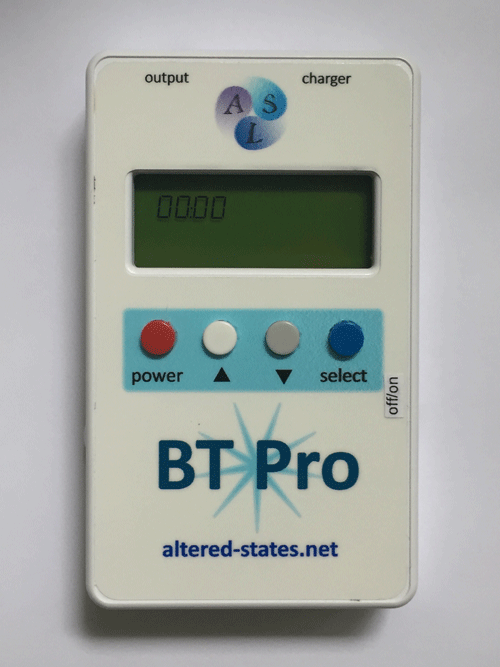
"Homeostasis can be
defined as the tendency for intrinsic
balance within a system. Application
of a range of CES appears to enhance
the Balance of the biological central
nervous system. A change in one system
within the individual will have correlative
effects upon other systems. Improvements
in mood, cognitive function, self image,
shift of Focus , control to oneself,
and sense of well being can be measured.
When CES works, it enhances one's ability
to handle or deal with situations that
were previously beyond the range of one's
control."
More info
|
|

|
Get Rid of the Fats that Accumulate
in Your Arteries
What Is Coronary Artery Disease?
Coronary artery disease (CAD), also called
coronary heart disease, is a condition in
which plaque (plak) builds up inside the
coronary arteries. These arteries supply
your heart muscle with oxygen-rich blood.
Plaque is made up of fat, cholesterol (ko-LES-ter-ol),
calcium, and other substances found in the
blood. When plaque builds up in the arteries,
the condition is called atherosclerosis (ATH-er-o-skler-O-sis).
Plaque narrows the arteries and reduces blood
flow to your heart muscle. It also makes it
more likely that blood clots will form in your
arteries. Blood clots can partially or completely
block blood flow

Heart
attacks and Stokes
Artery
Disease Begins in Childhood
The study examined the arteries
of young people who died of other causes, such
as suicide, homicides and accidents.
One-fifth of the young men aged
30-34 already had advanced plaques, or deposits
of fat, inside their coronary artery, pointing
the way toward future heart attacks and strokes.
Males were more than twice as likely to have
the plaques than women of the same age range.
The biggest risk factors for
a clogged artery were found to be obesity and
a high level of low-density lipoprotein or
LDL, the so-called bad cholesterol that forms
deposits on artery walls. Those with LDL levels
above 160 milligrams per deciliter were 2 ½ times
more likely to have one of these advanced plaques.
Other risk factors, such as smoking,
high blood pressure, and having a low level
of high-density lipoprotein or HDL, known as
the “good” cholesterol, also put
people at a slightly higher risk of artery
blockage. Source
"First, each
time new nicotine arrives in our brain
it causes the body to activate its
fight or flight stress defenses. This
in turn causes the immediate release
of stored fats into the bloodstream,
fats intended to be used to provide
the instant energy needed to either
fight or flee the saber tooth tiger.
But there is no tiger
The heavy blasts
of stored fats released by nicotine
stick to vessel walls damaged by
toxic carbon monoxide. Sound bad?
It gets worse. We've recently learned
that nicotine itself, inside our
vessels, somehow causes the growth
of new blood vessels (vascularization)
that then provides a rich supply
of oxygen and nutrients to the fats
and plaques that have stuck to damaged
vessel walls. This internal nicotine
vascularization (vessels within vessels)
hardens a smoker's arteries and veins
and further accelerates their narrowing
and clogging."
|
Later
During the aging process the
artery walls may become weakened. Coronary
artery disease occurs when deposits of fatty
material, cholesterol and other substances
form plaque that collects in the thinned or
weakened parts of the artery wall. The plaque
may then thicken and harden forming calcium
deposits that may eventually block the arteries
and restrict blood flow to the heart. This
condition is known as atherosclerosis or "hardening
of the arteries."
A blockage in an artery also
increases the pressure of blood pumping through
the vessel causing high blood pressure. Elevated
blood pressure requires the heart to work much
harder to pump blood to all body parts in need.
Over time as the heart is forced to work at
unusually high levels, it can become enlarged
and lose its' ability to function. High blood
pressure is the number one risk factor for
heart disease and congestive heart failure,
a condition where the heart is no longer able
to pump enough blood to meet the demands of
the body.
Symptoms
of Coronary Artery Disease
The most common symptom of coronary artery disease is angina, or chest
pain. Angina can be described as a discomfort, heaviness, pressure, aching,
burning, fullness, squeezing, or painful feeling in your chest. It can
be mistaken for indigestion or heartburn. Angina is usually felt in the
chest, but may also be felt in the shoulders, arms, neck, throat, jaw,
or back.
Other
symptoms of coronary artery
disease include:
Shortness of breath
Palpitations (irregular heart beats, skipped beats, or a "flip-flop" feeling
in your chest)
A faster heartbeat
Weakness or dizziness
Nausea
Sweating
Silent
heart attacks
|
Discomfort, pressure,
heaviness, or pain in the chest,
arm, or below the breastbone
Discomfort radiating to the back, jaw, throat, or arm
Fullness, indigestion, or choking feeling (may feel like heartburn)
Sweating, nausea, vomiting, or dizziness
Extreme weakness, anxiety, or shortness of breath
Rapid or irregular heartbeats |
|
|
If
an individual is not treated
within four to six minutes
from the onset of Sudden Cardiac
Arrest (SCA), the results can
be fatal. An SCA can be corrected
via a shock from an external
defibrillator or an implantable
cardioverter defibrillator
(ICD).
|
Unfortunately, as the
name suggests, SCA usually occurs
without any warning. As many as 2/3’s
of people who have attacks have no
prior indication of heart disease.
However, there are some symptoms
that can help you identify if someone
has just had an SCA: sudden collapse,
loss of consciousness, abnormal breathing,
an inability to find a pulse and
loss of blood pressure.
|
The most common heart attack symptom is
chest pain or discomfort. Most heart attacks
involve discomfort in the center or left
side of the chest that often lasts for more
than a few minutes or goes away and comes
back.
The discomfort can feel like uncomfortable
pressure, squeezing, fullness, or pain. The
feeling can be mild or severe. Heart attack
pain sometimes feels like indigestion or
heartburn.
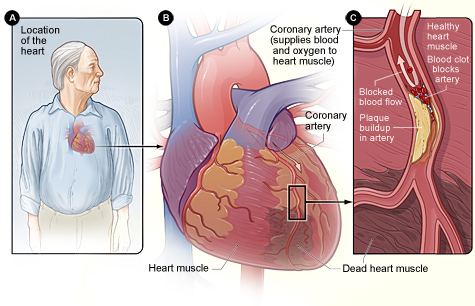
The symptoms of angina can be similar to
the symptoms of a heart attack. Angina pain
usually lasts for only a few minutes and
goes away with rest.
Chest pain or discomfort that doesn’t
go away or changes from its usual pattern
(for example, occurs more often or while
you’re resting) might be a sign of
a heart attack. If you don’t know whether
your chest pain is angina or a heart attack,
call 9–1–1.
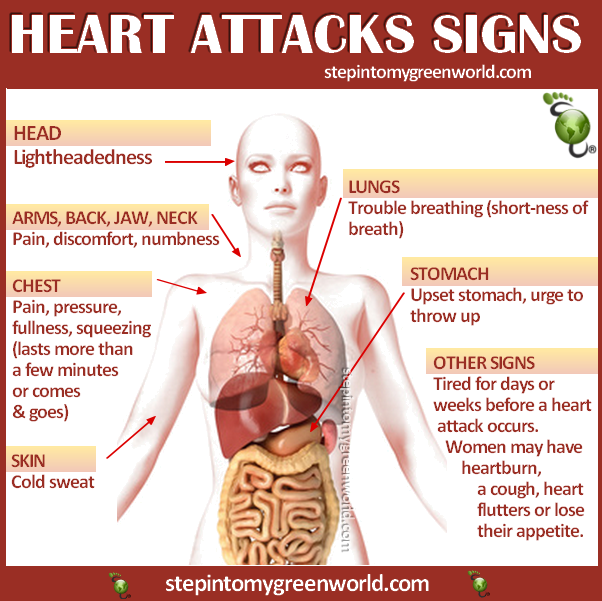
All chest
pain should be checked by a doctor.
Other common signs and symptoms of a heart
attack include:
Upper body discomfort in one or both arms,
the back, neck, jaw, or upper part of the
stomach
Shortness of breath, which may occur with or before chest discomfort
Nausea (feeling sick to your stomach), vomiting, light-headedness or fainting,
or breaking out in a cold sweat
Sleep problems, fatigue (tiredness), or lack of energy
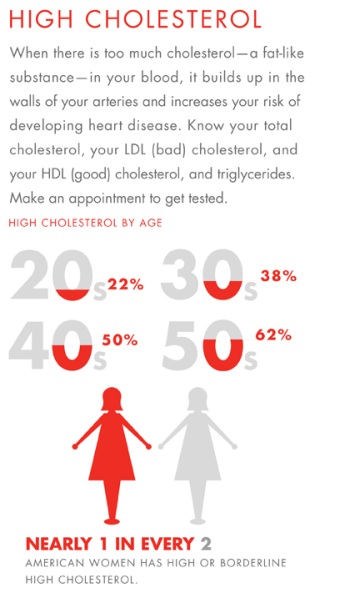
Fats Accumulate in Your
Arteries
More
information here
|
Wrist Blood
Pressure Monitor With Clear Digital Display
- Fully Automatic

Test the blood pressure & heart
rate
Blood
pressure monitor for the wrist Great
value for money digital wrist blood pressure
monitor, very compact with modern design.
Wrist Blood pressure monitor for the
wrist Great
value for money digital wrist blood pressure
monitor, very compact with modern design.
suitable
for . Reliable and clinically
validated this
monitor is CE certified
One BP monitor
|
| |
|
|
2 x Wrist
Blood Pressure Monitor With Clear Digital
Display - Fully Automatic

Test the blood pressure & heart
rate
Blood pressure monitor for the wrist
Great value for money digital wrist blood
pressure monitor, very compact with modern
design.
Wrist Blood pressure monitor for the
wrist Great value for money digital wrist
blood pressure monitor, very compact
with modern design. suitable for . Reliable
and clinically validated this monitor
is CE certified
TWO BP MONITORS
|
Four
Color 10 Beam 3 in 1Wrist Laser
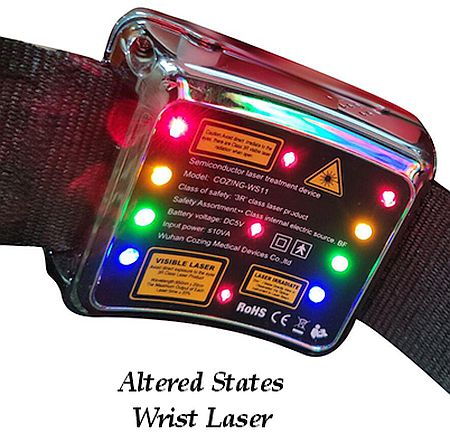
Red
Laser Activate Metabolism:
Lower Blood Pressure and Improve
Blood Flow
An unhealthy lifestyle enhance the possibility that cholesterol and other blood
fats build up on vessel walls and thus impair the oxygen and nutrient supply
to our organs. Laser light activates different enzymes and decomposes redundant
fat in the bloodstream. It increases the oxygen amount in the blood, boosts
metabolism and enhances the process of lipid peroxidation to reduce cholesterol
in the vessels.
Effects
of Green Light and Yellow Light
Yellow
light promotes serotonin
and vitamin D metabolism.Yellow
light stimulates the mitochondrial
respiratory chain at complex III (cytochrome)
and acts strongly detoxifying and anti-depressive.
Green
light binds to hemoglobin,
the ferrous blood compound in the
red blood cells. It improves the
function, behavior and cell elasticity
of those cells as well as the oxygen
supply.other effects: improved oxygen
affinity, decreases in lactic acid,
reduced blood viscosity, improved
blood flow, activation of reparative,
Effects
of Blue light Blue
light stimulates the first complex
of the respiratory chain (NADH dehydrogenase).
Effects: anti-inflammatory, enhances
NO production, activates telomerase
(Anti-Aging!) By increasing the activity
of fibroblasts blue light optimizes
wound healing and improves the oxygen
utilization in the tissue.
|
|
1. First Option: Wear
the laser watch
First Step: Wear the main machine
on the inner side of the left
wrist, as shown in the diagram,
so as to ensure the laser irradiates
radial artery and neiguan acupoint
precisely; and then fasten the
wrist strap.

|
| |
|
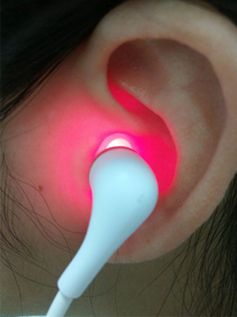 |
2. Second Option:: Use
the ear probe
Wear the ear probe in the ear,
insert the Ear probe accessory
in the topside accessory plug
of laser watch, (Reported by
many to be very helpful with
Tinnitus)
|
| |
|
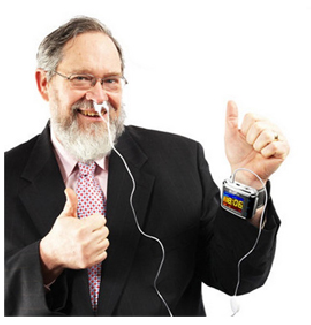 |
3. Third Option:: Nasal
probe
When changing tratement from
ear, to nose The nasal probe
uses the same accessory output
plug as the ear probe.
avoid
eye contact of laser.
|
Conclusions: In summary,
more than 25 years of experience of using
laser energy at 630-640 nm has shown
that this waveband directly influences
the parameters of all cells in the blood,
blood plasma, the coagulation process
and all the structural components of
the vascular wall. Additionally, ILBI directly
or indirectly affects the cells of the
immune system, hormones, and exchange
processes in an organism, thereby not
only improving the function of the vascular
system, but also the other systems of
an organism. It can finally
lead to lower the incidence and number
of vascular diseases, and indirectly
to the reduction of the number of diseases
in other organs and even systemically, thus
helping to prolong the lifespan. Source

Four
Color 10 Beam 3 in 1 Wrist
Laser
Laser energy at
630-650 nanometers is arguably
the most effective for irradiation
of blood and the vascular wall.
Photons at these wavelengths
are absorbed by oxygen, improve
microcirculation, can change
the viscosity of the blood and
affect vascular endothelium,
plus Smash viruses.
For general use,
they suggested 30min Two to three
times a day. (Wear only ON left
wrist)

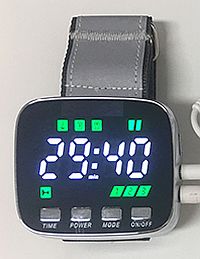 |
Four
Color 10 Beam 3 in 1
Wrist Laser
Power source
Lithium battery
Laser
probe for Ear 650nm
laser diode Max
5mW for each laser
diode
Laser
probe for nose 650nm
laser diode Max 5mW
for each laser diode
Laser
for wrist 650nm
laser diode (Red, plus Blue,
Green, Yellow laser)
USB charging
cable
Instruction manual

|
|
Standard fda required
warning
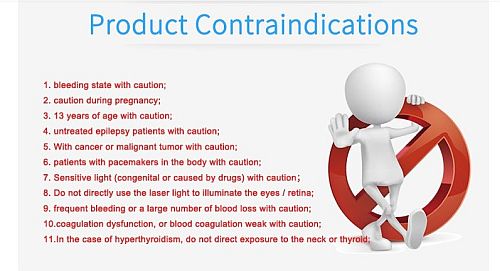
Sadly The web page authors after 39
years of working with alternative health
in our Free alternative clinic,are not
allowed to endorse the accuracy or reliability
of any of the information, content or
guidelines (collectively, the "Materials")
contained on, distributed through, or
linked, downloaded or accessed from these
links. You hereby acknowledge that any
reliance upon any Materials shall be
at your sole risk.
Caution
1)Not suitable for the following groups:cancer patient,pregnancy ,patient with
hemorrhagic disease.
2)Children shall only use the instrument under the direction of their parents.
3) The elder patients and sensitive patients must accept the low-power and
short treatment at the beginning,the rate of work could be increased as the
body adjusts.
Those of You interested
in the matter of laser blood irradiation
are welcome to check out the following
links that will help you learn more.
For specialists, we recommend the book
written by
Gejnic,
Moskvin, Achilov: Intravenal laser
blood irradiation, which is a comprehensive
source of information you won`t find
anywhere else. A part of it is published
on Russian servers. We have acquired
information from many sources from
this article. We focus Your attention
to S.V.Moskvin, a
significant specialist in this field
and the author of the article published
on the Medprosvet website. You can
find more information on the websites
below.
Similar
Articles for PMID: 25941421
|
Who's Online
There currently are 13 guests online.
|

